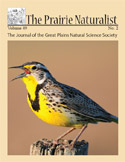Great Plains Natural Science Society

The Prairie Naturalist
Date of this Version
6-2010
Document Type
Article
Citation
The Prairie Naturalist· 42( l/2): June 20 I 0, pp 50-54
Abstract
In 1989, the U.S. Fish and Wildlife Service listed the western prairie fringed orchid (Platanthera praeclara) as threatened. Although this orchid has been monitored for years, there is little scientific documentation of its biology, ecology, and phenology, nor the impacts of management activities on its populations. Our objectives were to document seed germination and seedling production rates after one year in situ, and compare seed germination in grazed and non-grazed prairie habitat in the Sheyenne National Grassland (SNG) in southeastern North Dakota. Of 18,717 planted seeds, we recovered 1,561 swollen embryos, 94 protocorms, and 51 seedlings. We documented no difference in germination rate between seeds planted in grazed versus non-grazed prairie. However, our results suggested that 15 new flowering orchids may be produced from each flowering orchid that survives the growing season on the SNG. Thus, our findings confirm successful production of western prairie fringed orchid seedlings after one year in situ. Further research is needed to evaluate potential impacts of livestock grazing on other stages of the orchid life cycle, particularly protocorm and seedling survival rates.
Included in
Biodiversity Commons, Botany Commons, Ecology and Evolutionary Biology Commons, Natural Resources and Conservation Commons, Systems Biology Commons, Weed Science Commons

